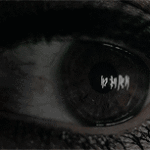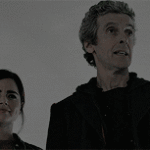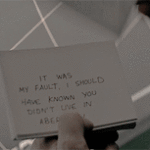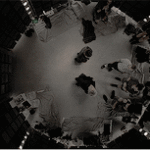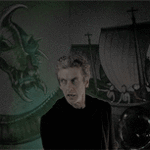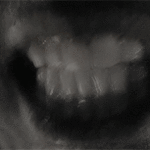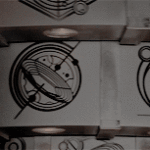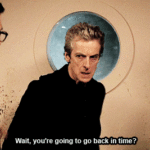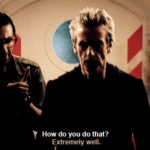Cass in Doctor Who’s “Under the Lake”: Deaf Representation?
If you hate spoilers, be warned: This post may contain some mild spoilers for the Doctor Who episode that aired last night, “Under the Lake”. If you haven’t seen it and don’t want to know what to expect when you do, then you may want to skip reading this. I don’t go into detail about the plot or what happened in the episode, but I do talk about how a certain character is portrayed.
SPOILER ZONE BEGINS HERE.
The guest character Cass is a rarity for science fiction: a disabled character. More specifically, a deaf character. And unlike the usual trope for some sub-genres (I’m thinking of the superhero genre in particular, though Doctor Who isn’t really in that genre), her disability is not used as a convenient excuse or shorthand for being a villain–because she’s not the villain at all. Since I’m deaf myself, one of my followers–a fellow Doctor Who fan–has expressed her interest in hearing my opinion about Cass and how her deafness was handled in last night’s episode.
I’m not going to do an in-depth, blow by blow analysis. For that, I would usually want to watch the episode a second time and take more detailed notes because sometimes I pick up on things the second time through that I missed the first time. But that would involve investing extra time, and then I might not get to it at all. So all that follows is just my immediate, off-the-cuff reactions.
Things I liked
- Cass is a real person. Not, of course, in the sense of being a non-fictional character. I mean, in the sense of someone with a sufficiently well-created, multi-dimensional personality that you can easily believe someone like her could exist. Not deeply complex or nuanced, because it’s hard to get into nuances when a character has only been on the screen for (so far) a single episode. But as far as you can get in the amount of screen time she has had.
- She wasn’t just about being the deaf woman. She had plenty of other traits not related to being deaf.
- Sure, in some ways, her character did fit into certain tropes. But the tropes were not deaf-related tropes, they were tropes about leaders during crisis. Cass is tough and is able to reach fast, but logically sound decisions during crisis–like many characters of leaders during crisis. She is also fiercely loyal to, and protective of, the group of people she commands. Although these tropes are common to leaders during crisis in fiction, they are very much not common to characters with disabilities, for the simple reason that disabled characters are not ordinarily leaders.
- Cass is in charge! Not that all disabled characters have to be in charge, of course. But as rare as it is to see a disabled character on the screen at all, it is even more rare to see someone in a reasonably responsible position. And more rare still for that responsible position to involve being a boss who makes key decisions. Including during times of fast-moving, life-and-death crisis!
- It is usually assumed that people with disabilities are always automatically more vulnerable during crisis and just a burden who makes it harder for the rest of the group to protect themselves as well as the poor disabled person in distress. It is, thus, also usually assumed that disabled people need to be kept far away from situations of crisis–both in real life and in fictional situations of crisis as well. On one hand, disability and the failure of others to provide reasonable accommodations for disability in crisis planning and response can and often does increase our risk of harm during times of crisis. But on the other hand, It is never considered that some of us might also, simultaneously, have areas of strength unrelated to our disabilities that allow us to be genuinely useful to a group during crisis as long as our needs are accommodated.
- Cass is not only the person the charge, she is intelligent–even the Doctor says that she is more intelligent than anyone else in the room when he’s not in it. Those of you who watch Doctor Who know that’s pretty high praise coming from him. She isn’t quite able to keep up with the Doctor, but that’s because none of us mere, less-clever humans are capable of that. Despite her inexperience with the weird, alien-related dangerous things that keep happening around the Doctor, she is still able to feel her way to some of the questions that need to be asked and make some of the fast decisions that need to be made.
Things I didn’t like
- I hated, hated, hated, the way that the role of the sign language interpreter was portrayed. Listen: sign language interpreters are not supposed to say, “she said this, she said that.” They’re only supposed to interpret what the person actually says. The only time they should use the phrase, “She said this,” in interpreting is if someone actually uses that phrase.
Completely made up example:
Andrea (in ASL): I think I saw a ghost
Interpreter (interpreting from ASL to English): I think I saw a ghost.
Somebody Else (in English, while looking at Andrea because they completely understand that Andrea is the person who was actually speaking): When you saw the ghost, did you scream?
Interpreter (interpreting from English to ASL): When you saw the ghost, did you scream?
Andrea (in ASL, while looking at Somebody Else because Andrea completely understands that it was Somebody Else speaking, not the interpreter): Gosh, no. I was too busy quaking in fear to scream because I’m not an awesome badass like Cass. I’m just glad that this is a completely made up conversation and that I didn’t actually see a ghost. I think Cass saw the ghost too, but I’m guessing probably she said, “Heck no, I don’t scare that easily.”
Interpreter (interprets everything from ASL to English, saying “I” when Andrea said “I”, saying “she said” when Andrea said “she said” and so on).
An interpreter’s job is to interpret. When a professional interpreter is serving in the role of an interpreter, they are ethically obligated not to participate in the conversation on their own behalf precisely to help avoid any confusion about who is actually saying “I think I saw a ghost” or whatever the statement is. This is an important principle that is heavily drilled into interpreters during interpreter training programs and is also spelled out in the interpreter professional code of ethics for many languages in many countries.
I realize that many hearing people are new to using an interpreter and this is why many hearing people are easily confused about who is doing the actual speaking. Or at least they are the first time they use an interpreter. But once they gain some experience in this, they get used to it and don’t find it so hard to keep remembering that them hearing the interpreter’s voice means that the deaf person is speaking in sign language. I’ve seen hearing people go through this learning curve a zillion times, so I know it can be done and isn’t actually as confusing as some people seem to think–when they’re still new to it.
But it doesn’t help inexperienced hearing people get pass this learning curve when television and other popular media keep showing fictional interpreters doing it all wrong. This is a great example of why TV (and film) producers really should be consulting with deaf people when they want to show deaf characters–and sign language interpreters–on the screen.
- Another thing I hated: I really hated how the camera kept disrespecting Cass’s language just because it was expressed via the hands instead of the voice. I didn’t understand most of her signs–because I use American Sign Language (ASL), not British Sign Language (BSL), which, yes, is a completely different language with very little shared vocabulary because neither ASL nor BSL is based on English at all. But it still would have been nice to see the camera respecting the language by clearly showing all of Cass’s lines on the screen, and not just some of them in haphazard in-and-out fashion. Sometimes we saw her face but her hands were cut off so we still couldn’t see the signs. Sometimes she wasn’t on the screen at all.
This is, sadly, a common problem on the few occasions that any fictional character in any genre is a signing deaf person. Even for television shows where you would think that the camera people and producers should have learned better by now, like Switched at Birth.
Yes, I realize that it is common in television and film for cameras to switch between focusing on the person who is speaking and the person or people who are listening to them to capture their reactions. But, spoken languages allow for that because the spoken lines can still be heard even when the camera isn’t on the speaker, and the speaker’s tone of voice and emotions can also still be heard. Signed languages just don’t work that way. To follow a signed conversation, the eyes need to stay on the person who is speaking. When filming a person who is signing, the same rules should still apply: the camera should stay on the person signing. The camera should only cut away from them for the reaction shots during natural pauses in the signer’s lines. It’s an insult to the language to make it so impossible for deaf viewers who know the language to follow along.
Reporters and photo journalists learn certain rules of etiquette in photography: one of them is that, when you take a picture of an athlete, you need to show the full body in the shot–head shots are usually avoided, especially if you are showing them in uniform or during athletic activities. Athletes are about keeping their bodies fit, frequently muscular, and in shape, and you’re supposed to show the whole person from head to toes in the shot so people can see how good they are at keeping their bodies in good athletic condition. Well, there should also be a certain etiquette in photography and filming when showing a signing person on the screen: Never, ever, ever allow their hands to be cut off. Always, always, always keep their hands inside the frame of the shot. Usually the best way to do this is to ensure that the camera always includes the person’s full signing space inside the frame. Most signs are executed within a certain space around the body running from about one foot (30 centimeters) above the head down to about the belly button area, and from about one foot (30 cm) outwards to the side from each shoulder. Only a few signs are likely to involve the hands going further outside this typical signing space, and then usually only if the person signing is emotionally agitated in some way because signing people who are angry or excited or upset or whatever sometimes make their signs a lot bigger in the same way that many speaking people talk louder when they are angry or excited. For a scripted show, it should be easy enough to avoid the problem either by instructing the actor to stay within signing space, or–if it is determined that the character is supposed to be agitated and making really large signs in a particular scene–by instructing the camera people to be prepared for a wider than usual shot to accommodate this.
There are deaf film makers out there (google names like Jules Dameron @julesdameron or Sabina England as just two examples, trying exploring the #DeafTalent tag in Twitter and elsewhere to find more). There have even been deaf produced talk shows or news shows (google for Deaf Mosaic, as one example of something I used to watch back in the 1980s and 1990s, but there are more). If you ever have the opportunity to watch something produced by a deaf film maker, pay attention to how deaf people’s bodies and their language are treated by the camera, and compare to examples of how hearing camera people and producers treat deaf people’s bodies and language when producing for mainstream television or film. The way most hearing people do it–including in last night’s episode of Doctor Who–is often disrespectful to us and our language and, personally, I found it offensive. Unfortunately, as I noted further above, it’s a common offense.
Summary:
Although there were aspects I didn’t like (explained above), it was still refreshing to see a deaf character who fell outside of the usual tropes for most other deaf or disabled characters in television. Since last night’s episode was apparently the first in a two-part story arc, I will be interested in seeing further developments next week Saturday when the second part airs in the United States.







